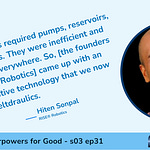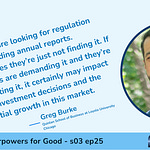Main Street Meets the SuperCrowd: Why This Conversation Matters
Jen Risley, the powerhouse editor behind the Main Street Journal, joined me once again for our monthly livestream—an ongoing collaboration we’ve come to call Main Street Meets the SuperCrowd. These conversations are quickly becoming a cornerstone of community-building for our shared audience—readers who are hungry for smart, actionable ideas to strengthen local economies, invest with impact, and think more holistically about systems change.
If you missed the livestream, let me offer a few highlights that made this session both thought-provoking and energizing.
A Meeting of Minds, Not Echoes
Jen and I began by acknowledging how similar our respective platforms are in terms of mission and audience. But this isn’t an echo chamber. Superpowers for Good and Main Street Journal approach the same problems from different angles, drawing on unique voices, frameworks, and solutions. That makes our collaboration not just refreshing, but necessary. As Jen put it, we’re both “scurrying and collecting” a deep basket of ideas and stories from the grassroots—ensuring that the best thinking doesn’t go unnoticed.
Trade Policy Meets Local Impact
One of the focal points of our conversation was an essay by Michael Shuman, the Publisher of the Main Street Journal, advocating for governors to consider using “negative tariffs” as a response to federal trade policy. Michael, a lawyer and economist, doesn’t just write for impact—he writes with it. His provocative suggestion: states could effectively subsidize imports that benefit local economies, pushing back against protectionist tariffs that often do more harm than good.
It’s a bold concept, and while it drew criticism from at least one reader, we found the idea worth exploring. The critique—that tariffs protect American jobs—misses the macroeconomic reality Michael articulates so well: we simply don’t manufacture like we used to. We’re not bringing back a 1950s economy, no matter how much we may long for it. What we can bring back is strong worker representation, living wages, and economic dynamism—and those don’t have to come from factories alone.
In fact, we discussed how strong unions, not just strong industries, were the real drivers of middle-class prosperity in the postwar era. What if we had a powerful union of fast-food workers today? Imagine how that might reshape not just wages, but career pathways in the service economy.
Rethinking Nonprofits: A Heated but Needed Conversation
We pivoted to another popular topic in Jen’s world—a recent post arguing that nonprofits are, in many cases, the least effective vehicle for systemic social change. That headline alone sparked strong reactions, particularly among those with nonprofit roots (Jen included). But the conversation went beyond provocation.
We examined the idea that nonprofits, for all their mission-driven focus, are structurally hampered by the need to chase grants and donors. This often means they spend more time fundraising than delivering on their mission. As Jen rightly pointed out, that dynamic saps not just time and energy but also local economic value.
Michael’s past reporting, including a 2005 Nation cover story co-authored with Marian Fuller, argues that even progressive nonprofits could do more by rethinking their business models. And we’re seeing that today—especially with entities like OpenAI, which began as a nonprofit but now operates as a public benefit corporation (PBC), a structure that allows it to serve a mission while generating revenue and attracting capital.
I pushed back just slightly—out of respect for the enormous good nonprofits have done. Since the time Michael and I were born, global poverty has dropped from over 50% to roughly 10%. That’s not magic. That’s decades of nonprofit work on health, education, and development. But when it comes to economic development—whether in Nairobi or Nebraska—it’s hard to deny that mission-driven businesses may have more horsepower than nonprofits constrained by annual fundraising cycles.
Return on Integrity: Why We Invest Local
We wrapped up by talking about a post I wrote recently: “25 Reasons to Invest Through Regulated Crowdfunding for Social Change.” Jen highlighted two that especially resonated with her. First, the power of recirculating dollars within a local economy. When a dollar is spent at a locally owned business, it circulates far more than a dollar sent to a national chain or an online platform. That’s not just economics—it’s a theory of change.
Second, Jen was struck by how regulated crowdfunding creates fertile ground for first-time investors. She herself started with a small investment—just $96—in The Super Crowd, Inc. That entry point matters. It lowers the barriers for ordinary people to participate in building the future they want to see. When investing is local, transparent, and accessible, it ceases to be the domain of Wall Street insiders and becomes a tool for anyone with $100 and a dream.
She also reminded us of a phrase I like to use: return on integrity. Impact investing isn’t just about profit—it’s about aligning your values with your money. It’s about sleeping better at night because you’re helping your neighbor launch a food truck or keep a childcare center open.
A Better Future with Better Tools
One other update I shared: we’ve launched a new due diligence tool for paid subscribers. Jen tested it out and found it easier and faster than our earlier prompt-based tool. While it doesn’t replace the full depth of a long-form analysis, it provides a meaningful synthesis of a company’s Form C—highlighting deal terms, risks, and key facts that too often go overlooked. This is especially important for newcomers who may be investing in a local business for the first time.
As I said during the livestream, we’re continuing to refine this tool. The goal is to build something that delivers the insight of a 20-hour research process in just 5 to 10 minutes—and makes it either free or radically affordable. That’s how we grow the movement.
Join the Movement
That word—movement—kept surfacing throughout our conversation. This isn’t just a monthly chat. It’s not just two newsletters. It’s part of a broader, rising effort to put capital in the hands of people building our communities—people often excluded from traditional finance.
So if you haven’t yet subscribed to both publications, I’ll make this pitch one more time: do it. Superpowers for Good is just $5.95/month or less with an annual plan. Main Street Journal offers insights you won’t find anywhere else. For the price of one streaming service, you can subscribe to both and get a stream of ideas that actually build the future.
Until next month, keep investing with your values, keep amplifying local voices, and keep believing in the power of the crowd.













